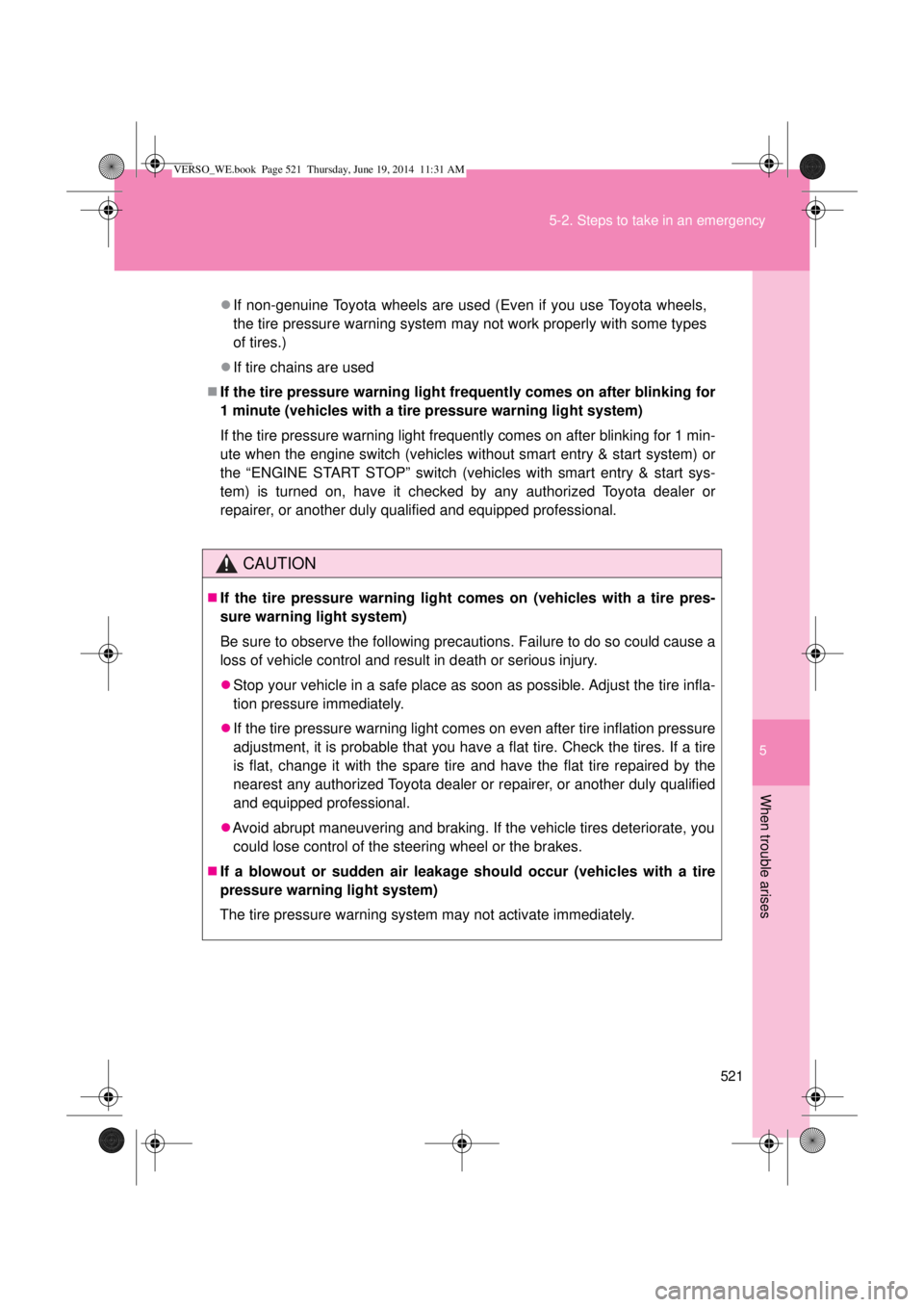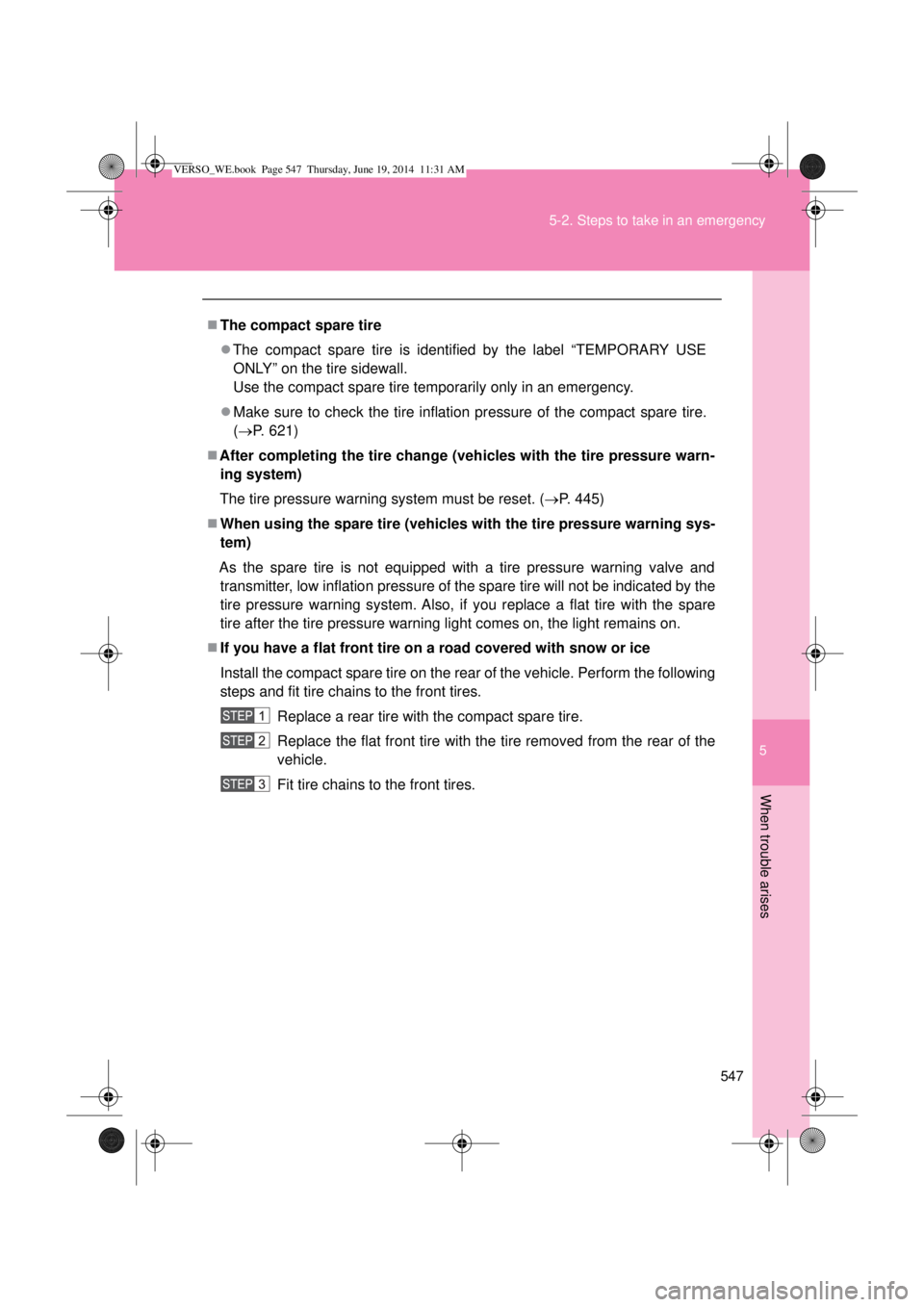Page 519 of 650

5
519 5-2. Steps to take in an emergency
When trouble arises
*1: Driver’s and front passenger’s seat belt reminder:
The driver’s and front passenger’s seat belts reminder sounds to alert the
driver and front passenger that their seat belts are not fastened. The buzzer
sounds for 30 seconds after the vehicle has reached a speed of at least
20 km/h (12 mph). Then, if the seat belts are still unfastened, the buzzer will
sound in a different tone for 90 more seconds.
*2: Rear passenger’s seat belt reminders:
The rear passenger’s seat belt reminder sounds to alert the rear passenger
that his or her seat belt is not fastened. The buzzer sounds for 30 seconds
after the vehicle has reached a speed of at least 20 km/h (12 mph). Then, if
the seat belt is still unfastened, the buzzer will sound in a different tone for
90 more seconds.
*3: 5-passenger models
*4: 7-passenger models
Front passenger detection sensor and passenger seat belt reminder
If luggage is placed on the front passenger seat, the front passenger
detection sensor may cause the warning light to flash, even if a passen-
ger is not sitting in the seat.
If a cushion is placed on the seat, the sensor may not detect a passen-
ger, and the warning light may not operate properly.
When the tire pressure warning light comes on (vehicles with a tire
pressure warning light system)
Inspect the appearance of the tire to check that the tire is not punctured.
If the tire is punctured: P. 536, 552
If the tire is not punctured:
Carry out the following procedure after the tire temperature has lowered suffi-
ciently.
Check the tire inflation pressure and adjust to the appropriate level.
If the warning light does not go out even after several minutes, check that
the tire inflation pressure is at the specified level and carry out initialization.
The warning light may come on again if the above operations are conducted
without first allowing the tire temperature to lower sufficiently.
VERSO_WE.book Page 519 Thursday, June 19, 2014 11:31 AM
Page 520 of 650

520 5-2. Steps to take in an emergency
The tire pressure warning light may come on due to natural causes
(vehicles with a tire pressure warning light system)
The tire pressure warning light may come on due to natural causes such as
natural air leaks and tire inflation pressure changes caused by temperature.
In this case, adjusting the tire inflation pressure will turn off the warning light
(after a few minutes).
When a tire is replaced with a spare tire (vehicles with a tire pressure
warning light system)
The spare tire is not equipped with a tire pressure warning valve and trans-
mitter. If a tire goes flat, the tire pressure warning light will not turn off even
though the flat tire has been replaced with the spare tire. Replace the spare
tire with the repaired tire and adjust the tire inflation pressure. The tire pres-
sure warning light will go off after a few minutes.
If the tire pressure warning system is not functioning (vehicles with a
tire pressure warning light system)
The tire pressure warning system will be disabled in the following conditions:
(When the condition becomes normal, the system will work properly.)
If tires not equipped with tire pressure warning valves and transmitters
are used
If the ID code on the tire pressure warning valves and transmitters is not
registered in the tire pressure warning computer
If the tire inflation pressure is 380 kPa (3.9 kgf/cm
2 or bar, 55 psi) or
higher
The tire pressure warning system may be disabled in the following condi-
tions:
(When the condition becomes normal, the system will work properly.)
If electronic devices or facilities using similar radio wave frequencies are
nearby
If a radio set at a similar frequency is in use in the vehicle
If a window tint that affects the radio wave signals is installed
If there is a lot of snow or ice on the vehicle, particularly around the
wheels or wheel housings
VERSO_WE.book Page 520 Thursday, June 19, 2014 11:31 AM
Page 521 of 650

5
521 5-2. Steps to take in an emergency
When trouble arises
If non-genuine Toyota wheels are used (Even if you use Toyota wheels,
the tire pressure warning system may not work properly with some types
of tires.)
If tire chains are used
If the tire pressure warning light frequently comes on after blinking for
1 minute (vehicles with a tire pressure warning light system)
If the tire pressure warning light frequently comes on after blinking for 1 min-
ute when the engine switch (vehicles without smart entry & start system) or
the “ENGINE START STOP” switch (vehicles with smart entry & start sys-
tem) is turned on, have it checked by any authorized Toyota dealer or
repairer, or another duly qualified and equipped professional.
CAUTION
If the tire pressure warning light comes on (vehicles with a tire pres-
sure warning light system)
Be sure to observe the following precautions. Failure to do so could cause a
loss of vehicle control and result in death or serious injury.
Stop your vehicle in a safe place as soon as possible. Adjust the tire infla-
tion pressure immediately.
If the tire pressure warning light comes on even after tire inflation pressure
adjustment, it is probable that you have a flat tire. Check the tires. If a tire
is flat, change it with the spare tire and have the flat tire repaired by the
nearest any authorized Toyota dealer or repairer, or another duly qualified
and equipped professional.
Avoid abrupt maneuvering and braking. If the vehicle tires deteriorate, you
could lose control of the steering wheel or the brakes.
If a blowout or sudden air leakage should occur (vehicles with a tire
pressure warning light system)
The tire pressure warning system may not activate immediately.
VERSO_WE.book Page 521 Thursday, June 19, 2014 11:31 AM
Page 547 of 650

5
547 5-2. Steps to take in an emergency
When trouble arises
The compact spare tire
The compact spare tire is identified by the label “TEMPORARY USE
ONLY” on the tire sidewall.
Use the compact spare tire temporarily only in an emergency.
Make sure to check the tire inflation pressure of the compact spare tire.
(P. 621)
After completing the tire change (vehicles with the tire pressure warn-
ing system)
The tire pressure warning system must be reset. (P. 445)
When using the spare tire (vehicles with the tire pressure warning sys-
tem)
As the spare tire is not equipped with a tire pressure warning valve and
transmitter, low inflation pressure of the spare tire will not be indicated by the
tire pressure warning system. Also, if you replace a flat tire with the spare
tire after the tire pressure warning light comes on, the light remains on.
If you have a flat front tire on a road covered with snow or ice
Install the compact spare tire on the rear of the vehicle. Perform the following
steps and fit tire chains to the front tires.
Replace a rear tire with the compact spare tire.
Replace the flat front tire with the tire removed from the rear of the
vehicle.
Fit tire chains to the front tires.
VERSO_WE.book Page 547 Thursday, June 19, 2014 11:31 AM
Page 561 of 650
5
561 5-2. Steps to take in an emergency
When trouble arises
Check the specified inflation pressure.
The label is placed as shown in the illustration.
Left-hand drive vehicles
Right-hand drive vehicles
Turn the compressor switch on
and fill the tire with air until the
specified inflation pressure is
reached.
Switch
VERSO_WE.book Page 561 Thursday, June 19, 2014 11:31 AM
Page 562 of 650
562 5-2. Steps to take in an emergency
Turn the switch off when the pressure gauge connected to the
hose reads the specified pressure.
If the inflation pressure is not attained within 5 minutes, emergency
repair is not possible due to severe damage. Contact any authorized
Toyota dealer or repairer, or another duly qualified and equipped pro-
fessional.
After completely filling the tire with air, disconnect the hose
from the valve on the tire.
Pull the power plug of the compressor out of the power outlet
on the vehicle.
To spread the liquid sealant evenly in the tire, immediately
drive for about 5 km (3 miles) or 10 minutes.
After driving about 5 km (3 miles)
or 10 minutes, pull your vehicle
over in a safe place and recon-
nect the compressor.
Read the inflation pressure on
the pressure gauge.
VERSO_WE.book Page 562 Thursday, June 19, 2014 11:31 AM
Page 567 of 650
5
567 5-2. Steps to take in an emergency
When trouble arises
Check the specified inflation pressure.
The label is placed as shown in the illustration.
Left-hand drive vehicles
Right-hand drive vehicles
Start the vehicle’s engine.
To inject the sealant and inflate
the tire, turn the compressor
switch on.
VERSO_WE.book Page 567 Thursday, June 19, 2014 11:31 AM
Page 568 of 650
568 5-2. Steps to take in an emergency
Inflate the tire until the specified
air pressure is reached.
The sealant will be injected
and the pressure will surge
and then gradually decrease.
The air pressure gauge will
display the actual tire inflation
pressure about 1 minute (5
minutes at low temperature)
after the switch is turned on.
Inflate the tire until the speci-
fied air pressure.
• If the tire inflation pressure is
still lower than the specified
point after inflation for 35 min-
utes with the switch on, the tire
is too damaged to be repaired.
Turn the compressor switch off
and contact any authorized
Toyota dealer or repairer, or
another duly qualified and
equipped professional.
• If the tire inflation pressure
exceeds the specified air pres-
sure, let out some air to adjust
the tire inflation pressure.
(P. 571, 621)
Turn the compressor off, then
press the button to release pres-
sure from the bottle.
VERSO_WE.book Page 568 Thursday, June 19, 2014 11:31 AM